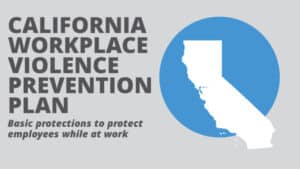Written By: Christopher B. Dolan
Following the horrific workplace shooting in San Jose this past week, NBC Bay Area Investigative Journalist Stephen Stock reached out to me to ask: “What are the rights of employees, and what are employer responsibilities when there is a threat of workplace violence?” I provided him a response that did air, but given the constraints of the evening news, I think it is important to provide a comprehensive analysis to the readers of this column.
According to data tracked by Everytown for Gun Safety (everytown.org), there have been 37 mass workplace shootings in California since 2009. Sadly, and notably, five of those mass murders occurred in just the last 10 weeks. Employees now, rightfully, are on high alert for signs and behaviors which may foretell a pending attack. According to experts, the following behaviors may indicate warning signs of pending workplace violence: threats of violence; intimidation; speaking about weapon ownership; intimidation; paranoia; angry and argumentative behavior; antisocial behavior like commenting favorably about violence in the news; and vindictive behavior such as saying, “he will get his,” or, “I’ll make her pay for that.” The United States Department of Labor has an excellent publication on the issue of workplace violence called the “DOL Workplace Violence Program.” It provides a guide that can be used in judging workplace behavior and what to look out for to predict and prevent workplace violence.
California Labor Code Section 6400 states that, “Every employer shall furnish employment and a place of employment that is safe and healthful for the employees therein.” Case law has held that Section 6400 creates an explicit public policy requiring employers to provide a safe and secure workplace, including a requirement that an employer take reasonable steps to address credible threats of violence in the workplace. Therefore, if there are threats of violence, or reasonable fears for your safety in the workplace, report it to your employer immediately. It is best to do so in writing so that a record is established.
An employee may not be forced to work in an unsafe work environment and, pursuant to California Labor Code Section 6310, it is unlawful for an employer to discipline or discharge any employee for making a complaint of an unsafe working condition to them, Cal-OSHA, or any other government agencies with a responsibility to protect workers. My office has represented workers who have refused to go back to a jobsite where their foreperson had made threats of violence or, in some instances, where they have been struck by an employee or co-worker. We have also represented workers that have been retaliated against after making a complaint to their employer about unsafe workplace conditions and/or threats of violence in the workplace. Likewise, we have represented workers fired after calling the police following an assault by a co-worker on the job. Employees who are retaliated against for making complaints of an unsafe workplace can recover economic damages such as lost pay, medical expenses, anxiety, grief, humiliation, and emotional distress. Tragically, I have also represented the family of a woman who, along with her boss and another supervisor, were shot and killed by a disgruntled employee who had made threats of violence which the employer did not take seriously.
Employers have a legal procedure that they can employ to prevent workplace violence. Pursuant to California Code of Civil Procedure (CCP) Section 527.8, “any employer, whose employee has suffered unlawful violence or a credible threat of violence from any individual, that can reasonably be construed to be carried out or to have been carried out at the workplace, may seek a temporary restraining order and an order after hearing for a permanent restraining order on behalf of the employee and, at the discretion of the court, any number of other employees at the workplace, and, if appropriate, other employees at other workplaces of the employer.”
“Course of conduct” is a pattern of conduct composed of a series of acts over a period of time, however short, evidencing a continuity of purpose, including following or stalking an employee to or from the place of work; entering the workplace; following an employee during hours of employment; making telephone calls to an employee; or sending correspondence to an employee by any means, including, but not limited to, the use of the public or private mails, interoffice mail, facsimile, or computer email. “Credible threat of violence” is a knowing and willful statement or course of conduct that would place a reasonable person in fear for his or her safety, or the safety of his or her immediate family, and that serves no legitimate purpose.
A Temporary Workplace Restraining Order can be filed using a form which can be found here. A workplace Restraining Order can ban an individual from coming near the workplace, near an employee, or their families, and it requires that the restrained person surrender any firearms that they may possess to the police. A temporary restraining order can be obtained by an employer, immediately, by filing Form WV-100, with the local court and serving the same on the employee and the local police. After a hearing, the temporary order can be extended for a period of up to three years.
Workplace violence is becoming an epidemic. No one should take threats lightly. Employees should report the warning signs and employers should act promptly. Reach out to a qualified trial lawyer to assist you, if necessary, to take action against your employer, should they fail to meet their responsibilities, or should you suffer retaliation If an employer fails to take immediate and appropriate action; an employee may seek a protective order themselves. That will be discussed in next week’s column.










